Author Archive
Friday, September 9th, 2011
If done correctly anchor text and reciprocal links can have a tremendous positive impact on SEO. These two concepts work together to provide valuable link value to your website and have the potential to increase your website ranking.
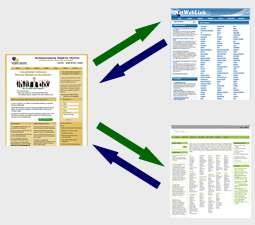
In our last blog entry “Creating Infographics to Build Links and Increase SEO” we briefly touched on the topic of Anchor text. The anchor text is the hyperlink or clickable text that is found on a web page. Using accurate anchor text is essential for good Search Engine Optimization and when used appropriately it can drastically boost your rankings in the search engines. The anchor text provides descriptive and useful information for the page that it links with.
The anchor text enables websites to use cleaner looking text rather than displaying an unpleasant and distracting hyperlink. For example a hyperlink for Internet Beacon.com would look like <a href=”http://www.internetbeacon.com”> Internet Beacon</a> however by using anchor text it would present as Internet Beacon on the page.
The most common mistake when dealing with anchor text is using the dreaded “Click Here” anchor text. Click here not only causes you to miss out on the possible SEO benefits it also neglects to describe the content to the page visitors and the search engine crawl bots. At one time Anchor text was heavily manipulated and was referred to as Google Bombing. Google Bombing used large amounts of anchor text to influence the rank of a link that directed visitors to unrelated content. For example during the 2004 United States presidential election the anchor text of “miserable failure” was linked to the George W. Bush‘s White House biography so many times that when users searched for the terms miserable failure the link to the biography appeared in Google’s search results. However in January, 2007, Google created a new algorithm which reduced the impact of Google bombs but none the less anchor text still remains important… Read the rest
Tags: anchor text, hyperlink, link, reciprocal links, search engine
Posted in Internet Marketing, Search Engine Optimization SEO | No Comments »
Friday, September 2nd, 2011
What is an Infographic? An infographic is a pictorial representation of specific data or knowledge. Infographics can be a great way to showcase information on a particular subject area and can prove to be a good source of link value. Infographics have the ability to transform plain material into interesting and exciting web content. Over the past few years the value of infographics has grown tremendously because many have begun to recognize the potential they have to connect with their target audience.
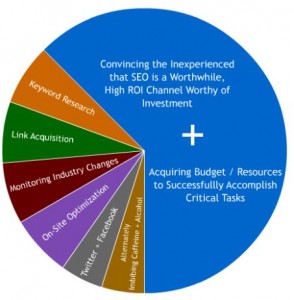
from http://www.seomoz.org/blog/4-essential-seo-infographics, September 2011
Link value or link juice is a term often used in Search Engine Optimization and refers to the amount of value that the search engines like Google attribute to a website or link. Link juice is assigned to web pages and is dispersed throughout a website based on how well your website is optimized. The more links and most importantly the more high quality links a website has directly translates into the more link juice a website is likely to have.
When talking about Links it is important to understand some important fundamentals. Total links quantity indicates the total number of links that your website or webpage possesses. The merit of these links can vary which brings us to the linking source. The linking source describes who is linking to your content and how credible or trustworthy they are. The sites that have a higher rank will pass on more value than those with a lower web rank. Even though the websites with a higher rank may provide more value it is also important to have diversity among your links. It’s ok to have links from lower ranked pages as long as there is a balance between link values.
Another major factor with links is anchor text. The anchor text is the keywords and descriptions other websites use when linking to your content. Accurate anchor text is essential for good SEO. You want something that describes your content well and not something like “Click… Read the rest
Tags: anchor text, backlinks, content, infographics, link juice, link value, linkbait, Links, seo, seo infographics
Posted in Backlinks, Internet Marketing, Search Engine Optimization SEO, Social Media Marketing | No Comments »
Friday, August 26th, 2011
One of the most important elements of creating a website is selecting a proper domain name. A domain name is commonly part of a larger Internet address called a “URL”. Having the right domain name for your website can significantly help establish an online reputation and generate greater visibility. Domain names give both the human visitors as well as the search engines the first description or impression of the website. Choosing a domain name can often be just as important as deciding the name of your business and should not be taken lightly. Finding a successful domain name will require time, patience, and creativity. The following tips are designed to assist in creating successful domain names.
Best Practices for Creating a Domain Name:
- Describe Your Website by Matching Your Domain, Website, and Company Name
A domain name is one of the first elements of a website that visitors see. Matching your domain with your company name will help target your existing as well as potential customers. Having a company and domain that describes your website will also let people know what the website is about and draw in targeted traffic. For example with the domain www.DeliciousPastries.com Delicious Pastries is the company name, website name, domain name, and also highlights Pastries a major descriptive keyword.

- Keep it Short and Readable-
There are several incentives for keeping your Domain name short which include it being easy to type, easy to remember, and easier to travel by word of mouth. A domain name that is longer than 3 words should use hyphens. However a domain name with more than 3 words and hyphens will raise the websites level of spamminess.
Having a keyword in your domain name will help rank not only because it is part of your domain but also because it is the anchor text that others will use to link back to your website.
- Alternative Domain Top Level Domains (TLD)
It’s recommended that you only purchase the .Com version of your… Read the rest
Tags: domain, domain names, internet, keywords, seo, url, urls, website
Posted in Internet Marketing, Search Engine Optimization SEO, Web Development | 1 Comment »
Friday, August 19th, 2011
One of the most important and easiest Search Engine Optimization concepts is keyword placement. SEO Keyword placement refers to the integration of targeted keywords into locations on and off the webpage. Keywords or key phrases are generated to represent the terms that users search for when trying to locate your company and website. A website using the wrong or inaccurate keywords is as equally bad as a website that ignores keywords all together.
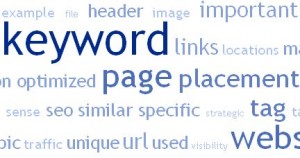
Keyword Cloud
Having accurate and descriptive keywords however is only the first part of the equation. Once you establish a list of relevant keywords they then need to be strategically placed throughout the website in order to increase traffic. Each individual page of your website should be optimized for one to three unique keywords. Selecting keywords along with the placement of these keywords is crucial in order to increase your website’s visibility and guide targeted traffic directly to your website. Below are the 10 most important positions to consider when performing keyword placement.
Where to Use Keywords:
It is recommended that you always place your keywords near the beginning of the title tag. Not using your keywords in the website’s title tag can make it extremely difficult to rank for your targeted keywords. Keyword placement in the title tag is thought to be the most important search engine ranking factors, each page title should be unique to that page and optimized for that specific keyword.
Although the Meta Description Tag seems to play a very little role in the actual search engine ranking it can still be used to influence potential customers to visit your website. Any keywords that your description tag has in common with the search query will appear bolded in the Search engine results page (SERP). Similar to the title tag each page should also have a unique description tag that targets only 1-2 keywords.
… Read the rest
Tags: Internet Marketing, keyword, keyword placement, keywords, Links, search engine, seo, website
Posted in Internet Marketing, Search Engine Optimization SEO, Web Tips | No Comments »
Friday, August 12th, 2011
Google’s Webmaster tools now provide users with a new way to submit new or updated URL’s for Google indexing. The fetch as Googlebot feature allows users to identify individual URL’s and submit them to Google’s crawl schedule for index consideration. Unlike the other methods of URL submission the Googlebots will crawl the submitted pages usually within one day of their submission. Although the response time is faster Google will still use the same selection process when considering a URLs inclusion in their index. The Fetch as Googlebot helps Google discover a web page faster but like its natural discovery process there is no guarantee that the page will be included in their index.
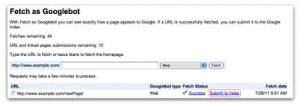
from http://googlewebmastercentral.blogspot.com/2011/08/submit-urls-to-google-with-fetch-as.html, August 2011
In order for Google to crawl and index a page it first needs to know that the site exists. The fetch as Googlebot feature may be a new and convenient method to submit a URL to Google but it’s not the only option. The process of discovery and can take place in a couple of different ways. Traditionally discovery occurs through links which is why it is extremely important to make sure that all your web pages are linked internally. Pages don’t always have external links connecting them, making internal links necessary for bots to travel from page to page.
Google also uses RSS feeds, XML Sitemaps, and Public URL Request to discover URLs that are not yet indexed. An XML Sitemap is a complete list of URL’s that you want Google to crawl for your website. The public URL request is an “Add URL” form that is available for anyone who wants to request that a URL be added to the index. Recently the add URL form has been renamed to the Read the rest
Tags: crawl, Google, google index, googlebot, index, link, submit url, urls
Posted in Web Development, Web Hosting, Web Tips | 2 Comments »
Wednesday, August 3rd, 2011
Most people can agree that social media has drastically changed the way businesses perform online marketing. Social media sites like Facebook and Twitter have provided businesses with the resources to create detailed portfolios and interact freely with their customers. Some companies even believe that Search Engine Optimization (SEO) is no longer important and social media should be their main focus.
Does SEO still matter? Social media sites have done a great job of connecting businesses with customers. However even with all the advantages that social media has to offer it shouldn’t replace SEO. Instead social media websites should be thought of as a complement to SEO rather than its substitute.
There are many benefits to using social media like attracting new clients, staying in contact with clients, and the ability to build a positive reputation. It’s clear that due to its popularity social media has begun to push other key SEO elements into the background but that doesn’t mean those elements are not still important. As important as Social media is it remains only one portion of the SEO puzzle. The following is a list of reasons why SEO still matters.
1. SEO Finds The People That Want to Find You!
Social networking will put you in front of other social media users but that doesn’t mean they are customers. With SEO you have a better chance of being found by buyers. Social media is often used to communicate with users that are already part of your circle whereas SEO can be used to draw in users to your circle.
2. SEO Provides More Relevance to Customers!
Social media can increase awareness of your company but with Search Engine Optimization you can specifically target customers seeking your product or service. SEO helps you rank for relevant searches which increases the chance of conversion. Additionally each keyword can be optimized to target a different group of consumers.
3. SEO Enhances The Conversion Process!
As mentioned, SEO focuses more on increasing the chances of conversion. SEO focuses on streamlining the conversion process. Every step… Read the rest
Tags: Internet Marketing, marketing, media, search engine optimization, seo, social, Social Media
Posted in Internet Marketing, Search Engine Optimization SEO, Social Media Marketing | No Comments »
Thursday, July 28th, 2011
Meta tags are special HTML tags that contain information or Meta data that is readable by browsers, search engines and other programs. Meta data is commonly referred to as “data about data”. It is documented information about a specific set of data and is essentially used to describe the contents of a webpage. Meta tags only contain page information, they do not change the appearance of the page. These tags are placed in the heading section of HTML code and are only visible to users when viewing the source page. The following is how Meta tags appear in a website’s source code.
<HEAD>
<TITLE>How to Create a Meta Tag</TITLE>
<META name =“description” content=”Everything you want to know about Meta Tags”>
<META name =”keywords” content=”Keyword 1, Keyword 2, Keyword 3, Keyword 4”>
</HEAD>
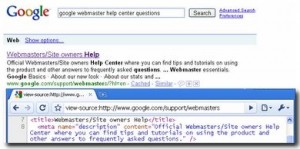
from http://googlewebmastercentral.blogspot.com/2009/09/google-does-not-use-keywords-meta-tag.html , July 2011
Are Meta Tags helpful? Meta tags are usually used for Search Engine Optimization and are thought to help web crawlers index your pages more accurately. Although at one time Meta tags held tremendous value for website ranking they no longer carry the same importance. Over time, less and less weight has been assigned to Meta tags due to their manipulation and user abuse. Eventually websites began to perform keyword stuffing (excessive use of keywords) and listed irrelevant information in their Meta tags to try to attract and mislead traffic to their pages. As users caught on to the black hat SEO techniques for Meta tags the search engines started to divert their attention and place more emphasis on actual content. Shifting their focus allowed the search engines to evaluate web pages appropriately based on visible content rather than depending on a Meta tag to deliver accurate information.
Meta tags no longer play the same critical role in SEO as they once did, but that doesn’t necessarily mean that they are all worthless. It is believed that certain Meta tags can still generate greater… Read the rest
Tags: content, keyword, Meta, Meta Tag, Meta Tags, search, search engine, tag, tags, webrank
Posted in Search Engines, Web Development | No Comments »
Friday, July 22nd, 2011
In February 24, 2011 Google introduced its new method for evaluating the quality of a website. Google Panda or “The Panda Algorithm” affected a little under 12% of search results and drastically reduced page visitors for many websites. At first 12% may seem like a small percentage but when considering the size of internet the figure becomes fairly significant. Google released Panda 2.0 in April and followed with version 2.1 in May. According to Search Engine Land Google had also just recently released its newest version (Panda 2.2) sometime during June.

from http://www.google.com/logos/logos11-2.html, July 2011
The Panda version 2.2 updates are thought to be the source behind the recent fluctuation in search listings and PageRank. Whether you experienced this change back in February or the new update is finally catching up with you, Google Panda seems to be impacting a tremendous number of websites and site owners across the Internet.
Although it is commonly called the Panda Algorithm, Google Panda is more of an individual Ranking factor rather than an entire new algorithm. Google uses a number of different factors when assigning a rank to a website. These factors are continually tweaked in order to provide the best user experience and return the most relevant search results. Search Engine Optimization (SEO) focuses on these evolving factors in an effort to increase site traffic and conversion rates. Although Google makes these adjustments to its ranking algorithm on a regular basis they usually go unnoticed or cause minor changes for most websites. However there have been a few major exceptions similar to the Google Panda update such as the Mayday Update of last year and the Vince Update in 2009.
How does Google Panda work? Google Panda acts as a filter to identify low quality pages. According to Matt Cutts the Panda Filter is not running all the time. Instead Panda performs periodic scans that occur during… Read the rest
Tags: Google, google pagerank, google panda, PageRank, panda, panda update, panda version 2.2, rank, ranking algorithm, update
Posted in Google, Search Engine Optimization SEO | No Comments »
Thursday, July 14th, 2011
Prior to last year’s release of WordPress Version 3.1, WordPress announced that 3.1 would be the last version to support PHP 4 and MySQL 4. During the announcement WordPress stated that version 3.2 could be expected early 2011 and emphasized that it would require PHP 5.2.4+ and a minimum of MySQL 5.0.15. The reason for their early announcement was to provide users with plenty of time meet the future requirements. At that time, WordPress had over 45 million users and 11% of those users were still using PHP 4. Along with the new requirements for PHP and MySQL, they also decided to drop support for legacy browsers such as Internet Explorer 6. Users who access the software using an outdated or unsupported browser will now be notified by a new built in feature.

WordPress 3.2.1 Upgrade Notice
WordPress 3.2 was released to the public last week, July 4, 2011. Focusing on a faster and lighter experience the WordPress 3.2 features a redesigned dashboard, Twenty-Eleven theme, admin bar, and a full screen editing mode. The new dashboard design removes the old administrator header and replaces it with the new and improved admin bar. The new admin bar now offers more options and links to important places within WordPress. In addition to the admin bar version 3.2 adds more drop down menus for easy navigation and a faster selection process. The redesigned dashboard provides a more seamless experience that can be fully customized. Another major feature with the 2011 release is the full screen distraction free text editor. With this feature users can focus completely on their writing and easily access hidden editor tools by hovering at the top of the editor. WordPress also adjusted and improved comment approval and reply options for a more streamlined conversation management.
Are you ready to update?
Before beginning the upgrade process users are advised to complete the following checklist
Tags: plugin, software release, update, upgrade, Wordpress, wordpress 3.2, wordpress 3.2.1, wordpress version 3.2
Posted in WordPress | No Comments »
Thursday, July 7th, 2011
YouTube is a video sharing site that works similar to a video search engine. YouTube differs from a video search engine because it does not utilize crawlers to search the internet for videos. Instead, YouTube relies on users to upload their own video files. Like most social media sites YouTube is a great resource for free marketing. Anyone with an account can upload a YouTube video, the real goal is to increase your presence and offer value or entertainment to the other users. The following tips focus on the various aspects of YouTube video optimization and are designed to increase your YouTube marketing efforts.

from http://www.youtube.com/ July 2011
Increasing Search Success:
Similar to Search Engine Optimization, one of your objectives is to use terms that your customers are searching for. Using the same words or phrases that are being searched for will make your video much easier to locate. Although they are not specifically designed for YouTube, some of the same tools used for SEO keyword research can also help generate some popular video search terms. With any marketing the step of selecting the right trigger words is vital either with or without the help of a keyword tool.
When it comes to keyword research and competitive analysis users can also gather information in a number of other ways. For example when performing a search on YouTube you can begin your research by paying attention to the auto suggestions that appear when typing. The auto suggestions identify the terms that other users have recently searched for that relate to your video’s topic. Gathering search patterns surrounding your topic enables you to target your audience more appropriately and will guide more traffic to your content. In addition to the search suggestions, YouTube also provides a list of related terms. Along with the related videos and search suggestion a marketer can also take cues from their competition. Performing competitive analysis by viewing the most popular videos on your subject is a sure fire way to generate new ideas… Read the rest
Tags: Internet Marketing, marketing, Video, video optimization, YouTube, YouTube advertising, YouTube video
Posted in Internet Marketing, Social Media Marketing | No Comments »
|